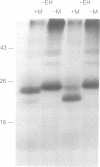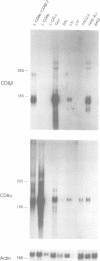Abstract
The CD8 glycoprotein plays important functions in T cell development and in T cell activation. In rodents, CD8 is a heterodimer, consisting of an alpha-chain (Lyt2) and a beta-chain (Lyt3). In humans, only the alpha-chain has been detected, and it has been thought that CD8 consists of homodimers of this protein. We have isolated functional cDNA clones encoding human CD8 beta, and show that the CD8 beta protein is expressed on the surface of CD8+ human T cells. cDNA clones encoding multiple forms of the human CD8 beta-chain have been isolated and characterized. These structural variants, which are likely to arise by alternative splicing, differ in the sequences encoding the cytoplasmic domain, which can consist of 19, 30, or 52 amino acids. One of the cDNAs lacks nucleotide sequences corresponding to a hydrophobic transmembrane domain, and may encode a secreted CD8 beta protein. The protein product of the human CD8 beta gene can be detected by a recently described anti-CD8 monoclonal antibody, 597. Expression of the epitope recognized by this antibody requires co-expression of the CD8 alpha and CD8 beta gene products. About 90% of human CD8 alpha positive thymocytes and peripheral blood lymphocytes express CD8 beta at the cell surface. Expression of the CD8 beta chain is thus conserved between human and rodents, and the variant CD8 beta polypeptides may have distinct roles in T cell function and development.
Full text
PDF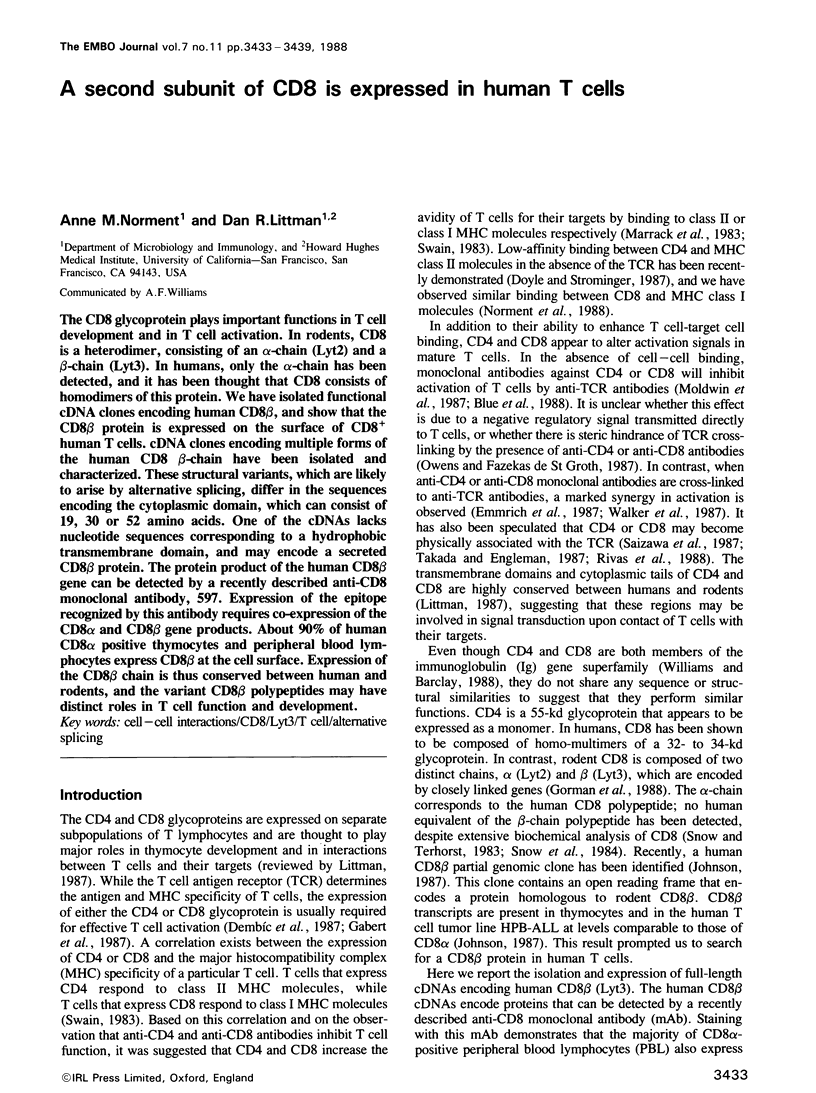
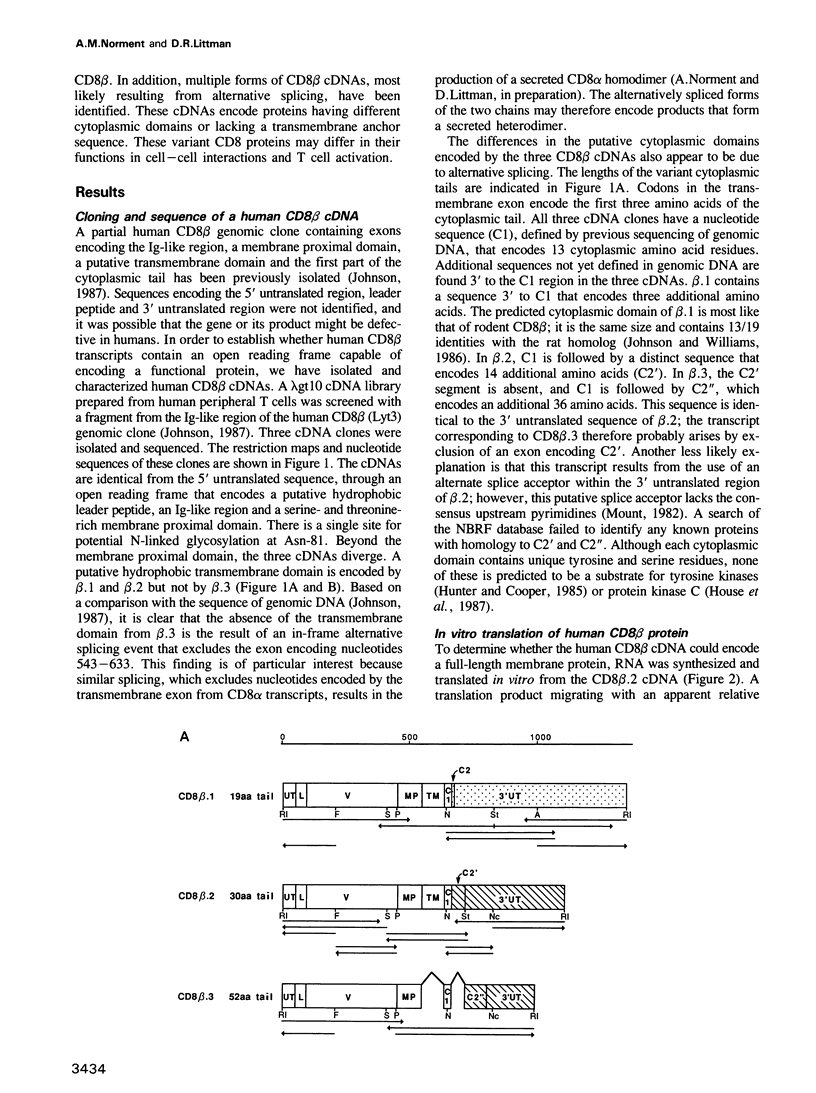
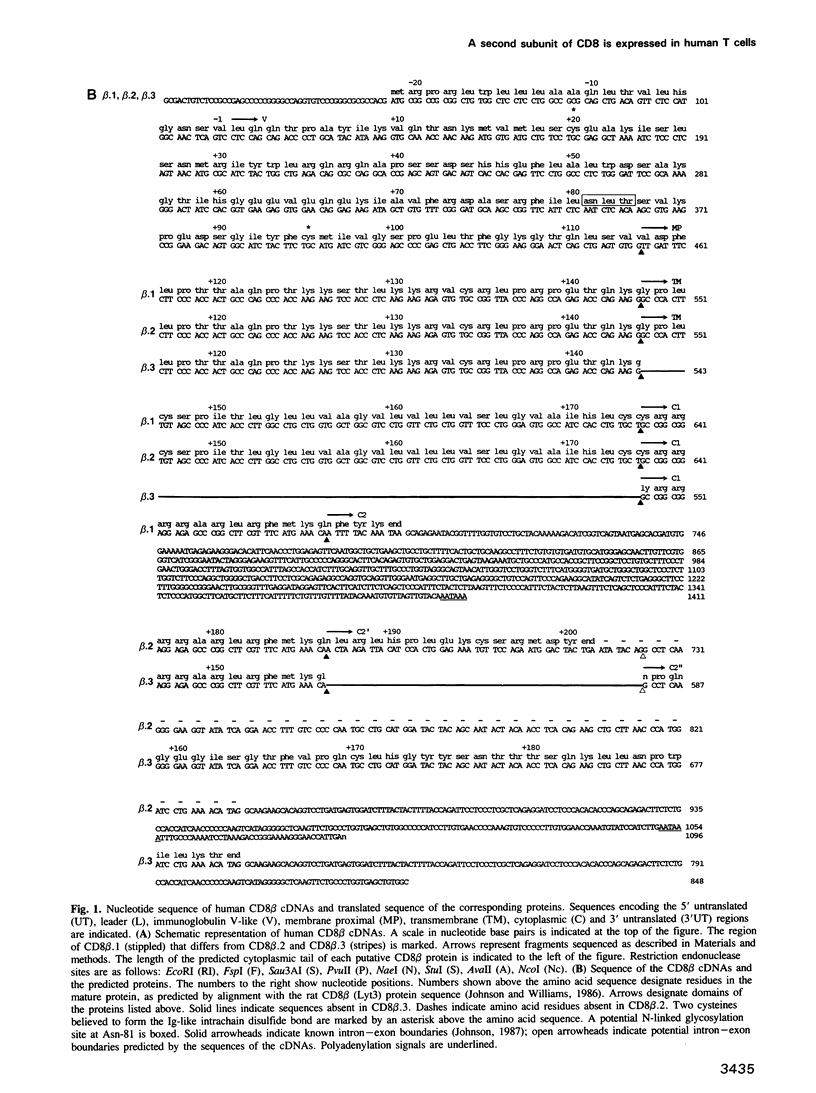
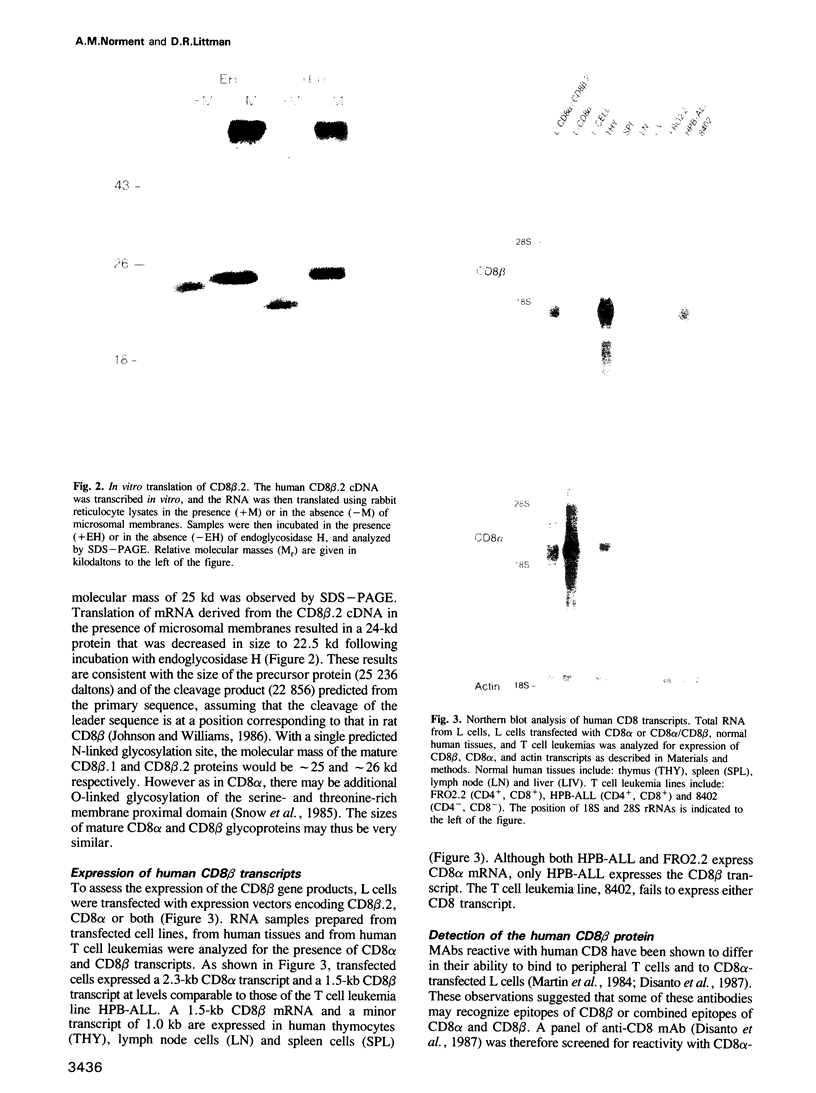
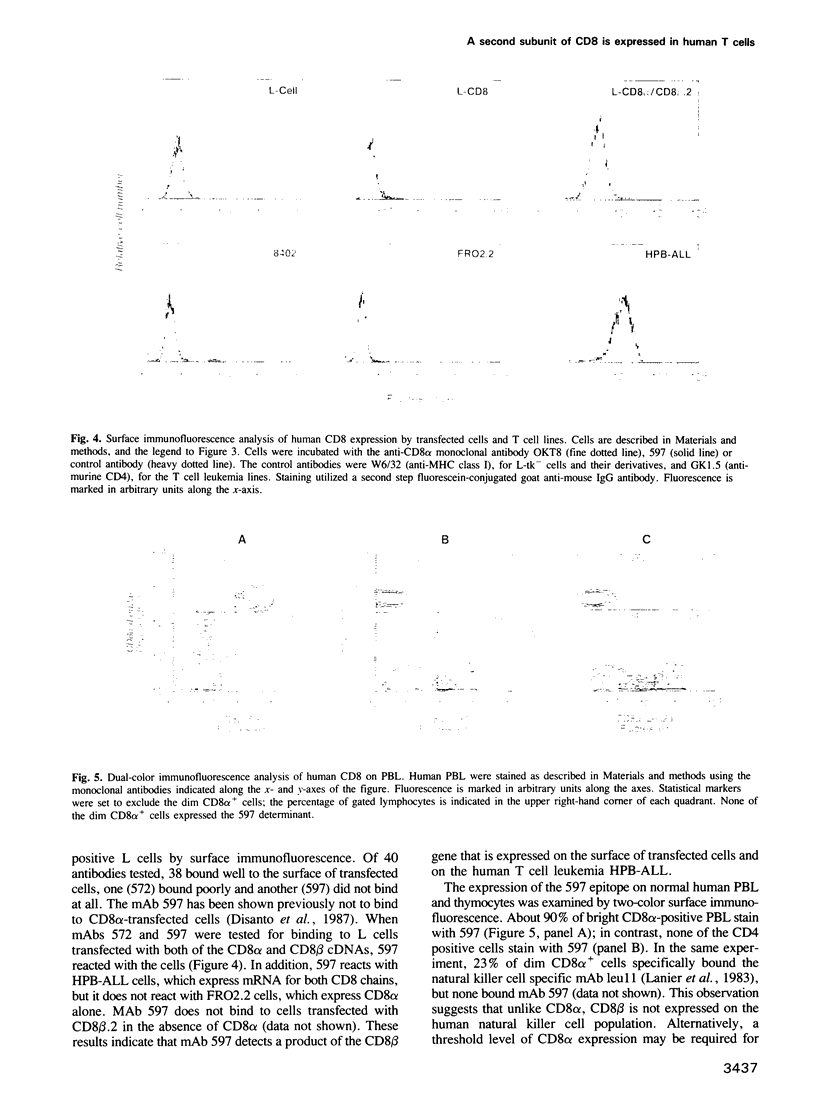
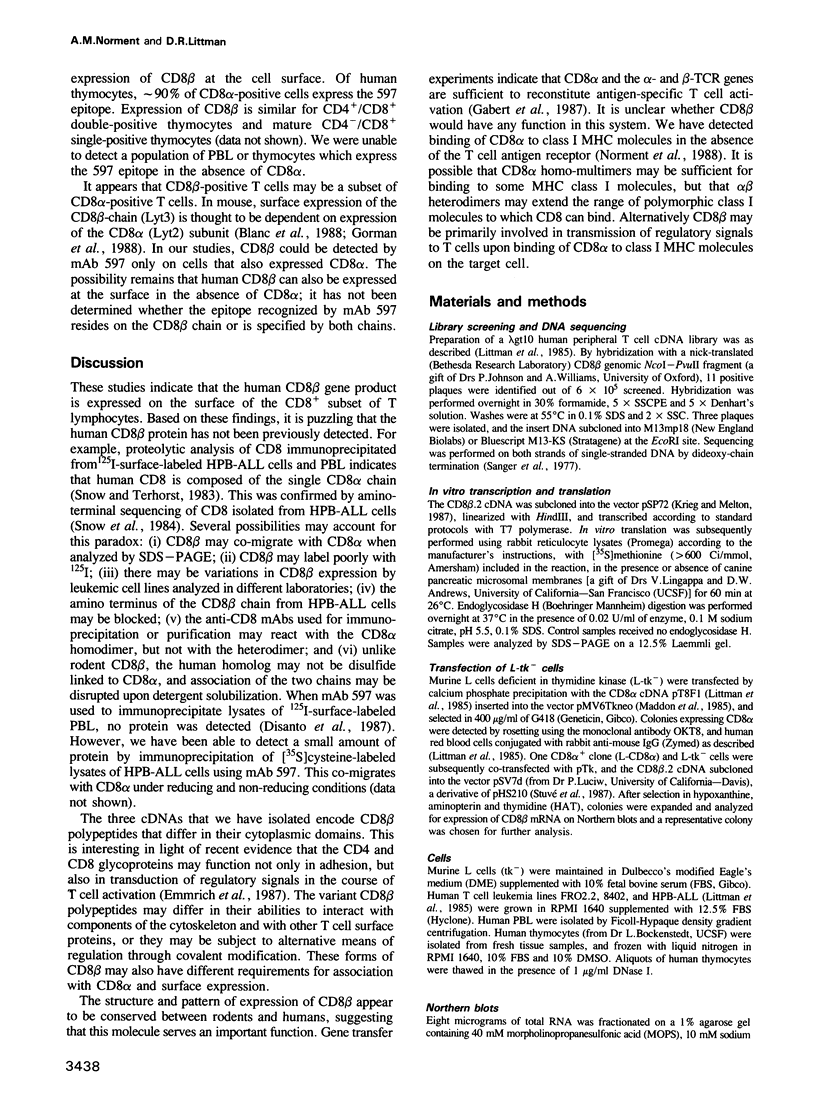
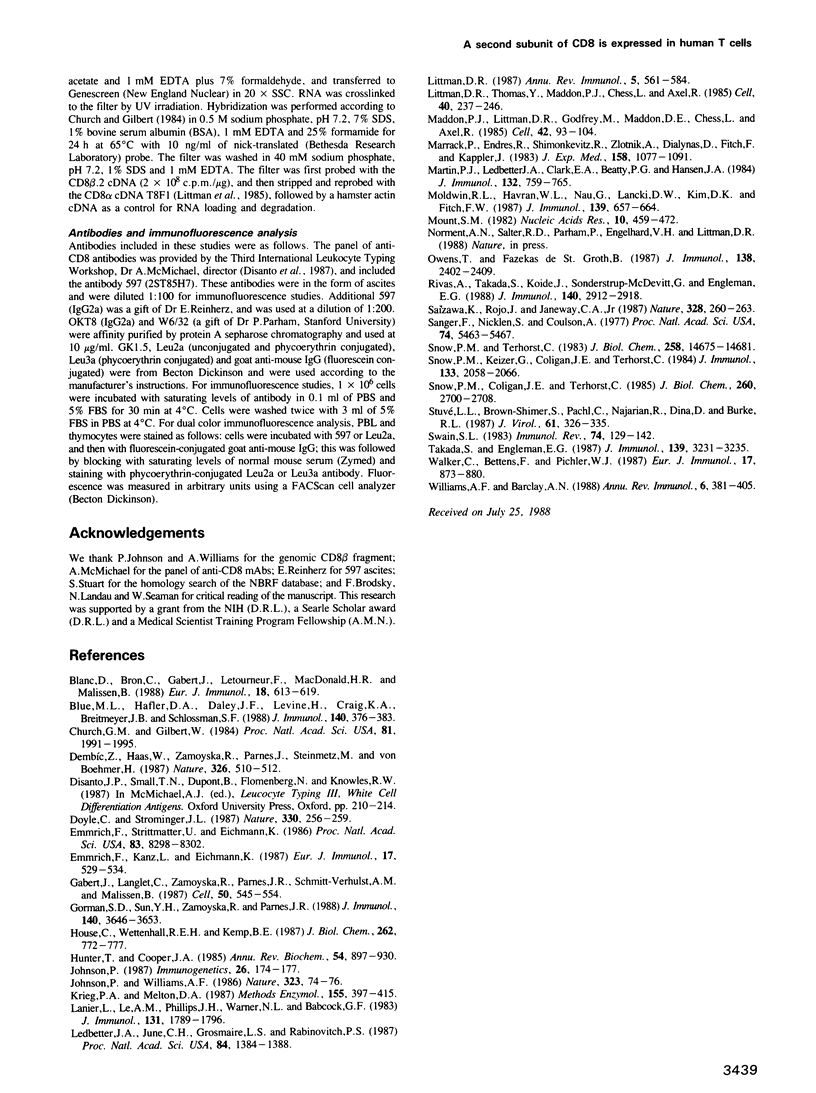
Images in this article
Selected References
These references are in PubMed. This may not be the complete list of references from this article.
- Blanc D., Bron C., Gabert J., Letourneur F., MacDonald H. R., Malissen B. Gene transfer of the Ly-3 chain gene of the mouse CD8 molecular complex: co-transfer with the Ly-2 polypeptide gene results in detectable cell surface expression of the Ly-3 antigenic determinants. Eur J Immunol. 1988 Apr;18(4):613–619. doi: 10.1002/eji.1830180419. [DOI] [PubMed] [Google Scholar]
- Blue M. L., Hafler D. A., Daley J. F., Levine H., Craig K. A., Breitmeyer J. B., Schlossman S. F. Regulation of T cell clone function via CD4 and CD8 molecules. Anti-CD4 can mediate two distinct inhibitory activities. J Immunol. 1988 Jan 15;140(2):376–383. [PubMed] [Google Scholar]
- Church G. M., Gilbert W. Genomic sequencing. Proc Natl Acad Sci U S A. 1984 Apr;81(7):1991–1995. doi: 10.1073/pnas.81.7.1991. [DOI] [PMC free article] [PubMed] [Google Scholar]
- Dembić Z., Haas W., Zamoyska R., Parnes J., Steinmetz M., von Boehmer H. Transfection of the CD8 gene enhances T-cell recognition. Nature. 1987 Apr 2;326(6112):510–511. doi: 10.1038/326510a0. [DOI] [PubMed] [Google Scholar]
- Doyle C., Strominger J. L. Interaction between CD4 and class II MHC molecules mediates cell adhesion. Nature. 1987 Nov 19;330(6145):256–259. doi: 10.1038/330256a0. [DOI] [PubMed] [Google Scholar]
- Emmrich F., Kanz L., Eichmann K. Cross-linking of the T cell receptor complex with the subset-specific differentiation antigen stimulates interleukin 2 receptor expression in human CD4 and CD8 T cells. Eur J Immunol. 1987 Apr;17(4):529–534. doi: 10.1002/eji.1830170415. [DOI] [PubMed] [Google Scholar]
- Emmrich F., Strittmatter U., Eichmann K. Synergism in the activation of human CD8 T cells by cross-linking the T-cell receptor complex with the CD8 differentiation antigen. Proc Natl Acad Sci U S A. 1986 Nov;83(21):8298–8302. doi: 10.1073/pnas.83.21.8298. [DOI] [PMC free article] [PubMed] [Google Scholar]
- Gabert J., Langlet C., Zamoyska R., Parnes J. R., Schmitt-Verhulst A. M., Malissen B. Reconstitution of MHC class I specificity by transfer of the T cell receptor and Lyt-2 genes. Cell. 1987 Aug 14;50(4):545–554. doi: 10.1016/0092-8674(87)90027-4. [DOI] [PubMed] [Google Scholar]
- Gorman S. D., Sun Y. H., Zamoyska R., Parnes J. R. Molecular linkage of the Ly-3 and Ly-2 genes. Requirement of Ly-2 for Ly-3 surface expression. J Immunol. 1988 May 15;140(10):3646–3653. [PubMed] [Google Scholar]
- House C., Wettenhall R. E., Kemp B. E. The influence of basic residues on the substrate specificity of protein kinase C. J Biol Chem. 1987 Jan 15;262(2):772–777. [PubMed] [Google Scholar]
- Hunter T., Cooper J. A. Protein-tyrosine kinases. Annu Rev Biochem. 1985;54:897–930. doi: 10.1146/annurev.bi.54.070185.004341. [DOI] [PubMed] [Google Scholar]
- Johnson P. A human homolog of the mouse CD8 molecule, Lyt-3: genomic sequence and expression. Immunogenetics. 1987;26(3):174–177. doi: 10.1007/BF00365908. [DOI] [PubMed] [Google Scholar]
- Johnson P., Williams A. F. Striking similarities between antigen receptor J pieces and sequence in the second chain of the murine CD8 antigen. Nature. 1986 Sep 4;323(6083):74–76. doi: 10.1038/323074a0. [DOI] [PubMed] [Google Scholar]
- Krieg P. A., Melton D. A. In vitro RNA synthesis with SP6 RNA polymerase. Methods Enzymol. 1987;155:397–415. doi: 10.1016/0076-6879(87)55027-3. [DOI] [PubMed] [Google Scholar]
- Lanier L. L., Le A. M., Phillips J. H., Warner N. L., Babcock G. F. Subpopulations of human natural killer cells defined by expression of the Leu-7 (HNK-1) and Leu-11 (NK-15) antigens. J Immunol. 1983 Oct;131(4):1789–1796. [PubMed] [Google Scholar]
- Ledbetter J. A., June C. H., Grosmaire L. S., Rabinovitch P. S. Crosslinking of surface antigens causes mobilization of intracellular ionized calcium in T lymphocytes. Proc Natl Acad Sci U S A. 1987 Mar;84(5):1384–1388. doi: 10.1073/pnas.84.5.1384. [DOI] [PMC free article] [PubMed] [Google Scholar]
- Littman D. R. The structure of the CD4 and CD8 genes. Annu Rev Immunol. 1987;5:561–584. doi: 10.1146/annurev.iy.05.040187.003021. [DOI] [PubMed] [Google Scholar]
- Littman D. R., Thomas Y., Maddon P. J., Chess L., Axel R. The isolation and sequence of the gene encoding T8: a molecule defining functional classes of T lymphocytes. Cell. 1985 Feb;40(2):237–246. doi: 10.1016/0092-8674(85)90138-2. [DOI] [PubMed] [Google Scholar]
- Maddon P. J., Littman D. R., Godfrey M., Maddon D. E., Chess L., Axel R. The isolation and nucleotide sequence of a cDNA encoding the T cell surface protein T4: a new member of the immunoglobulin gene family. Cell. 1985 Aug;42(1):93–104. doi: 10.1016/s0092-8674(85)80105-7. [DOI] [PubMed] [Google Scholar]
- Marrack P., Endres R., Shimonkevitz R., Zlotnik A., Dialynas D., Fitch F., Kappler J. The major histocompatibility complex-restricted antigen receptor on T cells. II. Role of the L3T4 product. J Exp Med. 1983 Oct 1;158(4):1077–1091. doi: 10.1084/jem.158.4.1077. [DOI] [PMC free article] [PubMed] [Google Scholar]
- Martin P. J., Ledbetter J. A., Clark E. A., Beatty P. G., Hansen J. A. Epitope mapping of the human surface suppressor/cytotoxic T cell molecule Tp32. J Immunol. 1984 Feb;132(2):759–765. [PubMed] [Google Scholar]
- Moldwin R. L., Havran W. L., Nau G. J., Lancki D. W., Kim D. K., Fitch F. W. Antibodies to the L3T4 and Lyt-2 molecules interfere with antigen receptor-driven activation of cloned murine T cells. J Immunol. 1987 Aug 1;139(3):657–664. [PubMed] [Google Scholar]
- Mount S. M. A catalogue of splice junction sequences. Nucleic Acids Res. 1982 Jan 22;10(2):459–472. doi: 10.1093/nar/10.2.459. [DOI] [PMC free article] [PubMed] [Google Scholar]
- Owens T., Fazekas de St Groth B. Participation of L3T4 in T cell activation in the absence of class II major histocompatibility complex antigens. Inhibition by anti-L3T4 antibodies is a function both of epitope density and mode of presentation of anti-receptor antibody. J Immunol. 1987 Apr 15;138(8):2402–2409. [PubMed] [Google Scholar]
- Rivas A., Takada S., Koide J., Sonderstrup-McDevitt G., Engleman E. G. CD4 molecules are associated with the antigen receptor complex on activated but not resting T cells. J Immunol. 1988 May 1;140(9):2912–2918. [PubMed] [Google Scholar]
- Saizawa K., Rojo J., Janeway C. A., Jr Evidence for a physical association of CD4 and the CD3:alpha:beta T-cell receptor. Nature. 1987 Jul 16;328(6127):260–263. doi: 10.1038/328260a0. [DOI] [PubMed] [Google Scholar]
- Sanger F., Nicklen S., Coulson A. R. DNA sequencing with chain-terminating inhibitors. Proc Natl Acad Sci U S A. 1977 Dec;74(12):5463–5467. doi: 10.1073/pnas.74.12.5463. [DOI] [PMC free article] [PubMed] [Google Scholar]
- Snow P. M., Coligan J. E., Terhorst C. Analysis of the structure of the human T cell surface antigen T8 by limited proteolysis and chemical cleavage. J Biol Chem. 1985 Mar 10;260(5):2700–2708. [PubMed] [Google Scholar]
- Snow P. M., Keizer G., Coligan J. E., Terhorst C. Purification and N-terminal amino acid sequence of the human T cell surface antigen T8. J Immunol. 1984 Oct;133(4):2058–2066. [PubMed] [Google Scholar]
- Snow P. M., Terhorst C. The T8 antigen is a multimeric complex of two distinct subunits on human thymocytes but consists of homomultimeric forms on peripheral blood T lymphocytes. J Biol Chem. 1983 Dec 10;258(23):14675–14681. [PubMed] [Google Scholar]
- Stuve L. L., Brown-Shimer S., Pachl C., Najarian R., Dina D., Burke R. L. Structure and expression of the herpes simplex virus type 2 glycoprotein gB gene. J Virol. 1987 Feb;61(2):326–335. doi: 10.1128/jvi.61.2.326-335.1987. [DOI] [PMC free article] [PubMed] [Google Scholar]
- Swain S. L. T cell subsets and the recognition of MHC class. Immunol Rev. 1983;74:129–142. doi: 10.1111/j.1600-065x.1983.tb01087.x. [DOI] [PubMed] [Google Scholar]
- Takada S., Engleman E. G. Evidence for an association between CD8 molecules and the T cell receptor complex on cytotoxic T cells. J Immunol. 1987 Nov 15;139(10):3231–3235. [PubMed] [Google Scholar]
- Walker C., Bettens F., Pichler W. J. Activation of T cells by cross-linking an anti-CD3 antibody with a second anti-T cell antibody: mechanism and subset-specific activation. Eur J Immunol. 1987 Jun;17(6):873–880. doi: 10.1002/eji.1830170622. [DOI] [PubMed] [Google Scholar]
- Williams A. F., Barclay A. N. The immunoglobulin superfamily--domains for cell surface recognition. Annu Rev Immunol. 1988;6:381–405. doi: 10.1146/annurev.iy.06.040188.002121. [DOI] [PubMed] [Google Scholar]



